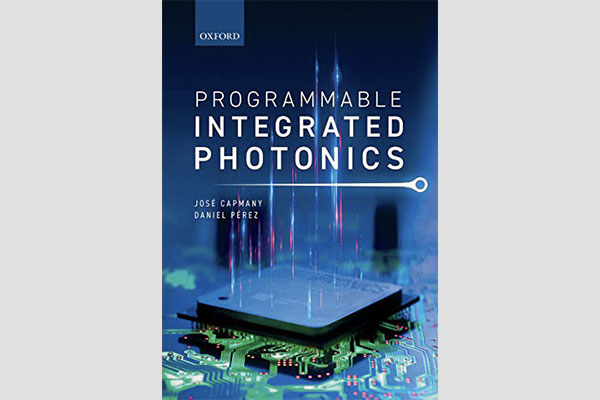By Ryan Aguinaldo
The field of photonic integrated circuits (PIC) has shown its maturity in recent years. Integrated photonic systems, once found chiefly in academic and R&D labs, are now routinely produced in the commercial market for a variety of end applications. Commensurate with the field’s maturity, several textbooks and monographs have been published in the last few years to either serve as introductions to PIC design methodology or as tutorials summarizing the vast literature. It is therefore timely and fitting for Capmany and Pérez to release their new contribution, which they assert is “the first comprehensive, up-to-date and self-contained introduction to the field of programmable integrated photonics.”
The underlying, implicit thesis of Programmable Integrated Photonics is that the “application specific photonic integrated circuit (ASPIC) paradigm completely dominated the field of integrated optics;” however, we are now at an inflection point where the demand of emerging applications will necessitate the PIC community to further mature towards providing systems with full flexibility and reconfigurability. On this note, the book takes off with an introduction to the fundamental technology and analogies to traditional electronic logic and field programmable gate arrays (FPGA). The reader is then instructed on common design and analysis techniques and is offered tutorials covering the evolution-to-date of PICs, especially those which have been “fundamentally application specific,” but which have also included reconfigure components; such work thus lays the foundation for fully programmable integrated photonics.
The remaining two-thirds of the book constitute the primary focus wherein less overlap of material is expected with other volumes generically covering integrated photonics. The integrated architectures that are covered fall broadly into the categories of multi-port interferometers and waveguide meshes. The former being used for arbitrary N×N unitary transformations and N×M non-unitary transformations in strictly feedforward configurations. The latter considers meshed topologies formed by a replicated unit cell where feedback is utilized. After highly theoretical descriptions of these architectures, issues of practical implementation are considered. To help justify the complexity of programming waveguide meshes, the authors describe the challenges faced by a hypothetical photonics designer relying on a non-programmable topology and iterated fabrication runs, who finally gets everything just right only to then be asked to add a new waveguide port. Undoubtedly, this is a situation faced by many former graduate students!
Various applications are then presented including, switching and routing, artificial intelligence and neural networks, microwave photonics, signal processing, and quantum computing. Of mild and inconsequential curiosity is that the chapter on quantum applications is placed prior to the chapter on classical applications, even as the authors admit that the “probably wider area of application of programmable integrated photonics is in classical systems.” Such chapter placement was likely chosen so that the classical applications can be juxtaposed with the book’s final chapter on Field Programmable Photonic Gate Arrays. This closing discourse is mostly a forward-looking discussion with some very preliminary results on the other things that are needed beyond programmable waveguide meshes to ultimately realize the photonic analogue of the electronic FPGA.
The introductory chapter of Programmable Integrated Photonics is to be noted for its brief yet compelling contrast between emerging programmable photonics and the rich history of programmable electronics along with its market drivers. Indeed, several references are made to excellent tutorials from the electronics literature, of which optical engineers may not necessarily be cognizant. The final chapter revisits and extends this contrasting discussion to further motivate and forecast trends for future photonic FPGAs.So is this a textbook for beginning graduate students or is it a monograph to give interested researchers a comprehensive review of the field? Programmable Integrated Photonics seems to be something in between. To the authors’ credit, the citations are exhaustive; however, the book does not have the flavor of merely elaborating on the best results found in the literature. Rather, design principles are intertwined in the discussion as are the potential issues a designer may encounter. Likewise, the mathematical description of the basic building blocks given at the beginning is complete and allows one to fully synthesis and analyze cascades of photonic components; however, later chapters may leave the reader wanting when an equation is seemingly pulled from the æther. Yet, that later chapters do not shy away from the mathematics goes far to showing the reader how to design programmable integrated photonics rather than only discussing past designs. This book will therefore be a useful addition equally to those wanting to learn its design principles and those looking for an up-to-date account of integrated photonics.




